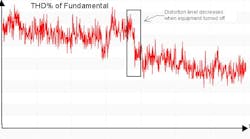Capacitors on power systems draw in higher frequency currents and can mislead an investigation. This article describes a way to find the source of a harmonic problem, but does not dive deep into a harmonics study itself, as there are existing articles and literature that provide that type of detailed information.
Briefly put, a single waveform capture can be mathematically broken down into its frequencies if the waveform is distorted. If there is no distortion in the waveform, then the only frequency that exists is the fundamental frequency. In the United States, the fundamental frequency is regulated at 60 Hz. Frequencies that are integer multiples of the fundamental frequency are known as harmonics. For example, assuming a 60-Hz fundamental frequency, the 2nd harmonic is 120 Hz, the 3rd harmonic is 180 Hz, the 5th harmonic is 300 Hz, and this continues on into the higher-order integers.
There are additional classifications that are identified but not covered in this article, which are sub-harmonics and interharmonics. Even-numbered harmonics are atypical and don’t appear often on the power system. What impacts the power systems are the odd ordered harmonics, such as the 3rd, 5th, 7, 9th, 11th, and so on. Odd ordered harmonics are typically generated by devices that have the capability of switching or chopping the incoming power to regulate voltage or drive the device. These devices can range from an LED lamp to a computer, all the way up to an adjustable speed drive (ASD) to run a motor.




